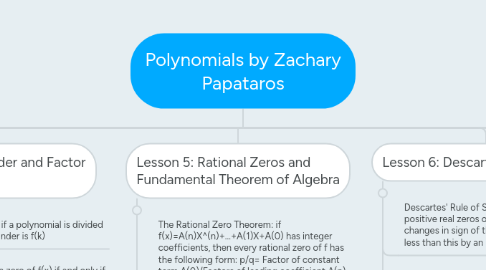Polynomials by Zachary Papataros
por Zachary Papataros


1. Lesson 1: Factor and Solve Polynomial Equations
1.1. Special Factoring Pattern
1.1.1. Sum of Two Cubes: a^3+b^3 (a+b)(a^2-ab+b62)
1.1.2. Difference of Two Cubes: a^3-b^3 (a-b)(a^2+ab+b^c
1.1.3. Quadratic Form: a(x)^2+b(x)+c
2. Lesson 2: Long Division of Polynomials
2.1. When dividing a polynomial P(x) by a divisor of D(x) you get a quotient of Q(x) and a remainder polynomial of R(x)
2.2. Method 1 Long division: dividing out polynomials like simple long divison
3. Lesson 3: Synthetic Division of Polynomials
3.1. Method 2 Synthetic Division: a quick method of dividing polynomials; it can be used when the divisor is of the form x-c
4. Lesson 4: Remainder and Factor Theorems
4.1. Remainder Theorem: if a polynomial is divided by x-k then the remainder is f(k)
4.2. Factor Theorem: k is a zero of f(x) if and only if (x-k) is a factor
5. Lesson 5: Rational Zeros and Fundamental Theorem of Algebra
5.1. The Rational Zero Theorem: if f(x)=A(n)X^(n)+...+A(1)X+A(0) has integer coefficients, then every rational zero of f has the following form: p/q= Factor of constant term A(0)/Factors of leading coefficient A(n)
5.2. The Fundamental Theorem of Algebra: If f(x) is a polynomial of degree n when n>0, then the equation f(x)=o has at least one solution in the set of complex numbers *if you consider the multiplicity of these roots, then there will be exactly n roots*
6. Lesson 6: Descartes' Rule of Signs
6.1. Descartes' Rule of Signs: The number of positive real zeros of f is equal to the number of changes in sign of the coefficients of f(x) or is less than this by an evan number
6.2. Descartes' Rule of Signs: The number of negative real zeros of f is equal to the number of changes of the coefficients of f(-x) or is less than this by an even number
7. Lesson 7: Complex and Irrational Conjugates
7.1. Complex Conjugates Theorem: If f is a polynomial function with real coefficients, and a+bi is an imaginary zero, then a-bi is also a zero if f
7.2. Irrational Conjugates Theorem: If f is a polynomial function with rational coefficients, and a and b are rational numbers such that the square root of b is irrational. If a+the square root of b is a zero of f, then a-the square root of b is also a zero of f
8. Lesson 8: Graphing Polynomial Functions
8.1. Polynomials with an Even Degree and Positive Leading Coefficients have an end behavior of as x goes to infinity, f(x) goes to infinity and as x goes to negative infinity f(x) goes to infinity
8.2. Polynomials with an Even Degree and Negative Leading Coefficients have an end behavior of as x goes to infinity, f(x) goes to negative infinity and as x goes to negative infinity f(x) goes to negative infinity
8.3. Polynomials with an Odd Degree and Positive Leading Coefficients have an end behavior of as x goes to infinity, f(x) goes to infinity and as x goes to negative infinity f(x) goes to negative infinity
8.4. Polynomials with an Odd Degree and Negative Leading Coefficients have an end behavior of as x goes to infinity, f(x) goes to negative infinity and as x goes to negtive infinity f(x) goes to infinity
8.5. Multiplicity of Zero: the number of times that it's associated factor appears in the polynomial
8.5.1. When the multiplicity of a zero is odd, the graph of the function crosses the x-axis at the zero
8.5.2. When the multiplicity of a zero is even, the graph of the function bounces the x-axis at the zero

